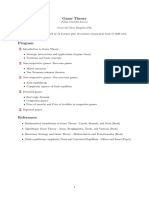Complete vs. Incomplete Information Games
Complete vs. Incomplete Information Games
Uploaded by
Czhoton RahmanCopyright:
Available Formats
Complete vs. Incomplete Information Games
Complete vs. Incomplete Information Games
Uploaded by
Czhoton RahmanOriginal Title
Copyright
Available Formats
Share this document
Did you find this document useful?
Is this content inappropriate?
Copyright:
Available Formats
Complete vs. Incomplete Information Games
Complete vs. Incomplete Information Games
Uploaded by
Czhoton RahmanCopyright:
Available Formats
3/30/2010
Complete vs. Incomplete Information Games
All games can be classified as complete information games or incomplete information games. Complete information games the player whose turn it is to move knows at least as much as those who moved before him/her. Complete information games include: Perfect information games players know the full history of the game, all moves made by all players etc and all payoffs game e.g. an extensive form game without any information sets. Imperfect information games games involving simultaneous moves where players know all the possible outcomes/payoffs, but not the actions chosen by other players. Incomplete information games: At some node in the game the player whose turn it is to make a choice knows less than a player who has already moved. Also called Bayesian games.
Imperfect vs. Incomplete Information Games
In a game of imperfect information, players are simply unaware of the actions chosen by other players. However they know who the other players are, what their possible strategies/actions are, and the preferences/payoffs of these other players. players Hence, information about the other players in imperfect information is complete. In incomplete information games, players may or may not know some information about the other players, e.g. their type, their strategies, payoffs or their preferences.
Example 1a of an Incomplete Information Game
Prisoners Dilemma Game. Player 1 has the standard selfish preferences but Player 2 has either selfish preferences or nice preferences. Player 2 knows her type, but Player 1 does not know 2s type 2 2
1 C D
4,4 6,0
0,6 2,2
1 C D
4,6 6,2
0,4 2,0
Player 2 selfish
Player 2 nice
Recall that C=cooperate, D=defect. If player 2 is selfish then player 1 will want to choose D, but if player 2 is nice, player 1s best response is still to choose D, since D is a dominant strategy for player 1 in this incomplete information game.
3/30/2010
Example 1b of an Incomplete Information Game
Prisoners Dilemma Game. Player 1 has the standard selfish preferences but Player 2 has either selfish preferences or nice preferences. Suppose player 1s preferences now depend on whether player 2 is nice or selfish (or vice versa). 2 2
1 C D
4,4 6,0
0,6 2,2
1 C D
6,6 4,2
2,4 0,0
Player 2 selfish
Player 2 nice
If 2 is selfish then player 1 will want to be selfish and choose D, but if player 2 is nice, player 1s best response is to play C! Be nicer to those who play nice, mean to those who play mean.
Example 1b in Extensive Form, Where Player 2s Type is Due to Nature
Information Set Prevents 1 From Knowing 2s Type and 2s Move
Example 1b Again, But With a Higher Probability that Type 2 is Selfish
3/30/2010
Analysis of Example 1b
Player 2 knows his type, and plays his dominant strategy: D if selfish, C if nice. Player 1s choice depends on her expectation concerning the unknown type of player 2.
If player 2 is selfish, player 1s best response is to play D. If player 2 is nice, player 1s best response is to play C.
Suppose player 1 attaches probability p to Player 2 being selfish, so 1-p is the probability that Player 2 is nice. Player 1s expected payoff from C is 0p+6(1-p). Player 1s expected payoff from D is 2p+4(1-p). 0p+6(1-p)= 2p+4(1-p), 6-6p=4-2p, 2=4p, p=1/2. Player 1s best response is to play C if p<1/2, D otherwise. In first version, p=1/3, play C; in second, p=2/3, play D.
The Nature of Nature
What does it mean to add nature as a player? It is simply a proxy for saying there is some randomness in the type of player with whom you play a game. The probabilities associated with natures move are the subjective probabilities of the player facing the uncertainty about the other players type. p y yp When thinking about player types, two stories can be told.
The identity of a player is known, but his preferences are unknown. I know I am playing against Tom, but I do not know whether he is selfish or nice. Nature whispers to Tom his type, and I, the other player, have to figure it out. Nature selects from a population of potential player types. I am going to play against another player, but I do not know if she is smart or dumb, forgiving or unforgiving, rich or poor, etc. Nature decides.
Example 2: Michelle and the Two Faces of Jerry
Dancing
Dancing
Frat Party
Dancing
Dancing
Frat Party
M
Frat Party
2,1 0,0
0,0 1,2
M
Frat Party
2,0 0,1
0,2 1,0
Jerry likes company
Jerry is a loner
Assume that Jerry knows his true type, and therefore,
which of the two games are being played.
Assume Michelle attaches probability p to Jerry liking
company and 1-p to Jerry being a loner.
Big assumption: Assume Jerry knows Michelles estimate
of p (assumption of a common prior).
3/30/2010
The Game in Extensive Form
Bayes-Nash Equilibria
Bayes-Nash equilibria is generalization of Nash equilibrium for an incomplete information game. 1. First, convert the game into a game of imperfect information. 2. Second, use the Nash equilibria of this imperfect information game as the solution concept. Apply this technique to the Michelle and Jerry Game. Game
Michelles pure strategy choices are Dancing, D, or Party P. She can also play a mixed strategy, D with probability l. Jerrys strategy is a pair, one for each type of Jerry: the first component is for the Jerry who likes company (Jerry type 1) and the second component is for Jerry the loner (Jerry type 2). Pure strategies for Jerry are thus (D,D), (D,P), (P,D), and (P,P). Jerry also has a pair of mixed strategies g1 and g2 indicating the probability Jerry plays D if type 1or if type 2. Focus on pure strategies.
Pure Strategy Bayes-Nash Equilibria
Suppose Michelle plays D for certain l=1. Type 1 Jerry plays D. Type 2 Jerry plays P: Jerry (D,P). Does Michelle maximize her payoffs by playing D against the Jerrys pure strategy of (D,P)?
With probability p, she gets the D,D payoff 2, and with probability
1-p she gets the D,P payoff, 0. So expected payoff from D against Jerry (D,P) is 2p. If instead, she played P against Jerry (D,P), she would get with probability p, the P,D payoff, 0 and with probability 1-p she gets the P,P payoff, 1. So expected payoff from P against Jerry (D,P) is 1-p. Thus playing D against Jerry (D,P) is a best response if 2p > 1-p, or if 3p >1, or if p > 1/3. If p>1/3, it is a Bayes-Nash equilibrium for Michelle to play D, while the Jerrys play (D,P).
3/30/2010
Pure Strategy Bayes-Nash Equilibria, Contd.
Next suppose Michelle plays P for certain l=0. Type 1 Jerry plays P. Type 2 Jerry plays D: Jerry (P,D). Does Michelle maximize her payoffs by playing P against the Jerrys pure strategy of (P,D)?
With probability p, she gets the P,P payoff 1, and with probability
1-p she gets the P,D payoff, 0. So expected payoff from P against y( , ) p Jerry (P,D) is p. If she instead played D against Jerry (P,D), she would get with probability p, the D,P payoff, 0 and with probability 1-p she gets the D,D payoff, 2. So the expected payoff from D against Jerry (P,D) is 2(1-p). Finally, playing P against Jerry (P,D) is a best response if p > 2(1-p), or if 3p >2, or if p > 2/3. If p>2/3, it is a Bayes-Nash equilibrium for Michelle to play P, while the Jerrys play (P,D).
Summary
If p > 2/3, there are 2 pure-strategy Bayes-Nash equilibria
1. 2. Michelle plays D, the Jerrys play (D,P). Michelle plays P, the Jerrys play (P,D).
If 2/3 > p > 1/3 there is just 1 pure strategy Bayes Nash equilibrium, #1 above, where B N h ilib i b h Michelle plays D and the Jerrys play (D,P). In our example, p=1/2, so Michelle should play D and the two Jerrys play (D,P). If p < 1/3 there is no pure strategy Bayes-Nash equilibrium.
Example 3: Market Entry Game With An Unknown Number of Entrants
Another kind of incomplete information game is where the set of players you are playing against are unknown as in this example.
Incumbent does not know if he faces 1 entrant or a joint venture involving 2 entrants, as indicated by the dashed information sets
3/30/2010
Analysis of Example 3
Three players, first entrant, second entrant, incumbent. Consider the subgames that arise conditional on the second entrants strategy: accept or decline the invitation by first entrant for a joint venture. Since the first entrant always moves first and the incumbent does not observe his moves, we can treat moves these subgames as 2 player, simultaneous-move games between the first entrant and the incumbent only. There are two such games: If the second entrant declines, and if the second entrant accepts.
If the Second Entrant Declines
Middle payoff of 0 is the second entrants payoff. Second entrant has no choice in this subgame. Evidently, the unique Nash equilibrium of this subgame is fight, stay out, yielding a payoff to the incumbant, second entrant, first entrant of (3,0,0).
If the Second Entrant Accepts
The unique Nash equilibrium of this subgame is accommodate, propose joint venture, yielding a payoff to the incumbant, second entrant, first entrant of (0,4,4).
3/30/2010
What Does the Second Entrant Do?
The second entrant compares the payoffs in the two Nash equilibria: (3,0,0) versus (0,4,4) She would choose the equilibrium that yields (0,4,4), since her payoff in that equilibrium 4, is g p y q greater than the 0 payoff she gets in the other equilibrium. Therefore, the second entrant accepts the first entrants proposal for a joint venture. The unique Nash equilibrium of this incomplete information game is the strategy (propose joint venture, accept, accomdoate) as played by the first entrant, second entrant and the incumbant.
Incomplete Information and the Design of Incentives
In many instances we would like for payoff incentives to depend on actions that are unobservable our information about such actions are incomplete, for example, work effort, or the care of a rental car. Strategic interactions where one playerss actions are unobservable or not verifiable by the other player give rise to moral hazard problems: the l th player who is informed of his actions or intentions has an incentive h i i f d f hi ti i t ti h i ti to behave inappropriately from the perspective of the other player who is less informed about his actions or intentions. Examples: A worker knows his effort level, but his boss does not. A purchaser of insurance knows how careful he has been securing his belongings while the insurer is less informed. In such situations, the less informed player must provide the more informed player with appropriate incentives that are designed to minimize the moral hazard problem.
Example 1: Deductibles & Co-Pays
Suppose there were no cost to you of seeing your doctor your insurance company paid for all visits/prescriptions without argument. In that case, you might reason that it is not so important to stay healthyafter all, you can see the doctor for pills anytime you need them, and the insurance company cannot observe your efforts to remain healthy. A consequence is that doctors and ff i h lh i h d d pills would be requested more than in the case where your efforts to maintain your health were perfectly observable. Solution: Insurance companies charge you a deductible or copays for every expense you charge to your insurance account. This cost sharing works to overcome the moral hazzard problem and improve unobserved efforts at remaining healthy.
3/30/2010
Example 2: Merit Pay for Teachers
We would like to reward teachers for exerting effort, but their teaching efforts are in large part, unobservable . We do observe the test scores of the students of a teacher, so we may try to derive an incentive system based on those observables. With standard effort, a teachers students will perform above average on tests 50% of the time, and below average 50% of the time. If the teacher exerted more effort, say 20 more hours per school year, she could increase the likelihood that her students performed above average on tests to 80%. The extra effort, however is costly the 20 hours come out of the teachers leisure time and are valued to her at her hourly wage of $30 to be worth $30x20=$600. What amount of bonus, b, would induce the teacher to exert the extra 20 hours of effort? We want b such that .5b < .8b-$600. Or $600 < .3b, b>$600/.3 =$2,000.
Merit Pay Continued
Consider, however, where the bonus money comes from. Suppose the legislature declares that each classroom with above state average test scores can get money from the state equal to $2,000 which could be passed on to teachers note this is their indifference level. Suppose further that if all teachers exerted the extra effort, the average test scores would increase, so that, on average 50% of increase that classes would score above average and the rest below average. In this case, the exertion of the extra effort would not be worth it, since there is no change in the percentage pass rate and exerting the extra effort costs $600. Hence, an equilibrium would exist in which no teacher exerted extra effort, 50% would get the $2,000 bonus and the other 50% would not, and merit pay would have no effect. There would also be a mixed equilibrium, where some exerted effort and some did not, but all exerting effort is not an equilibrium.
You might also like
- PH - D - Ordinances and Regulations at IIT RoorkeeNo ratings yetPH - D - Ordinances and Regulations at IIT Roorkee24 pages
- Transfiguration, Trans-Location, and Translation100% (1)Transfiguration, Trans-Location, and Translation14 pages
- Econ 1051: Section 2 Notes: 1. Problem Set 1, Question 3No ratings yetEcon 1051: Section 2 Notes: 1. Problem Set 1, Question 35 pages
- Bayesian Games: 1: Definition and EquilibriumNo ratings yetBayesian Games: 1: Definition and Equilibrium20 pages
- Sequential Games of Perfect Information UPFNo ratings yetSequential Games of Perfect Information UPF58 pages
- Microeconomics II: Game Theory and Its ApplicationsNo ratings yetMicroeconomics II: Game Theory and Its Applications31 pages
- Lecture 21 - Game Theory, Strategic Equilibrium, and Repeated InteractionsNo ratings yetLecture 21 - Game Theory, Strategic Equilibrium, and Repeated Interactions15 pages
- Lecture III: Normal Form Games, Rationality and Iterated Deletion of Dominated StrategiesNo ratings yetLecture III: Normal Form Games, Rationality and Iterated Deletion of Dominated Strategies12 pages
- HE302 Game Theory Paper - Love Is IrrationalNo ratings yetHE302 Game Theory Paper - Love Is Irrational11 pages
- Lecture Notes On Game Theory: Brian WeathersonNo ratings yetLecture Notes On Game Theory: Brian Weatherson142 pages
- The Fundamental Theorem of Games: Yana Peysakhovich September 23, 2007No ratings yetThe Fundamental Theorem of Games: Yana Peysakhovich September 23, 200716 pages
- Coordination Game and Battle of Sexes Lecture 04 - Game TheoryNo ratings yetCoordination Game and Battle of Sexes Lecture 04 - Game Theory3 pages
- Game Theory: Universit e Paris Dauphine-PSLNo ratings yetGame Theory: Universit e Paris Dauphine-PSL41 pages
- Lecture III: Normal Form Games, Rationality and Iterated Deletion of Dominated StrategiesNo ratings yetLecture III: Normal Form Games, Rationality and Iterated Deletion of Dominated Strategies17 pages
- Prisoner's Dilemma: A Case Study: February 11, 2015No ratings yetPrisoner's Dilemma: A Case Study: February 11, 20154 pages
- Basic Assumptions of The Game Theory: I N N I NNo ratings yetBasic Assumptions of The Game Theory: I N N I N6 pages
- School Foundation Course (Work, Energy and Power Physics)No ratings yetSchool Foundation Course (Work, Energy and Power Physics)6 pages
- A Student Has To Choose Any One of The Second Languages As Per The Availability of The Course in CollegeNo ratings yetA Student Has To Choose Any One of The Second Languages As Per The Availability of The Course in College5 pages
- Absorption - Human Nature and Buddhist LiberationNo ratings yetAbsorption - Human Nature and Buddhist Liberation271 pages
- PH - D - Ordinances and Regulations at IIT RoorkeePH - D - Ordinances and Regulations at IIT Roorkee
- Econ 1051: Section 2 Notes: 1. Problem Set 1, Question 3Econ 1051: Section 2 Notes: 1. Problem Set 1, Question 3
- Microeconomics II: Game Theory and Its ApplicationsMicroeconomics II: Game Theory and Its Applications
- Lecture 21 - Game Theory, Strategic Equilibrium, and Repeated InteractionsLecture 21 - Game Theory, Strategic Equilibrium, and Repeated Interactions
- Lecture III: Normal Form Games, Rationality and Iterated Deletion of Dominated StrategiesLecture III: Normal Form Games, Rationality and Iterated Deletion of Dominated Strategies
- The Fundamental Theorem of Games: Yana Peysakhovich September 23, 2007The Fundamental Theorem of Games: Yana Peysakhovich September 23, 2007
- Coordination Game and Battle of Sexes Lecture 04 - Game TheoryCoordination Game and Battle of Sexes Lecture 04 - Game Theory
- Lecture III: Normal Form Games, Rationality and Iterated Deletion of Dominated StrategiesLecture III: Normal Form Games, Rationality and Iterated Deletion of Dominated Strategies
- Prisoner's Dilemma: A Case Study: February 11, 2015Prisoner's Dilemma: A Case Study: February 11, 2015
- School Foundation Course (Work, Energy and Power Physics)School Foundation Course (Work, Energy and Power Physics)
- A Student Has To Choose Any One of The Second Languages As Per The Availability of The Course in CollegeA Student Has To Choose Any One of The Second Languages As Per The Availability of The Course in College

























































































